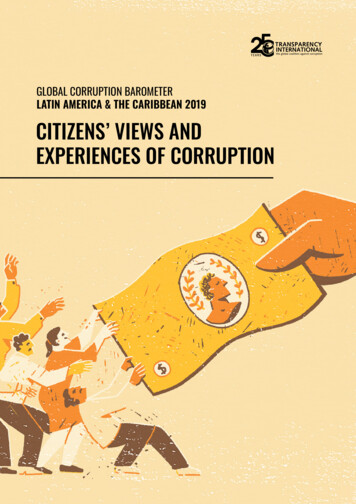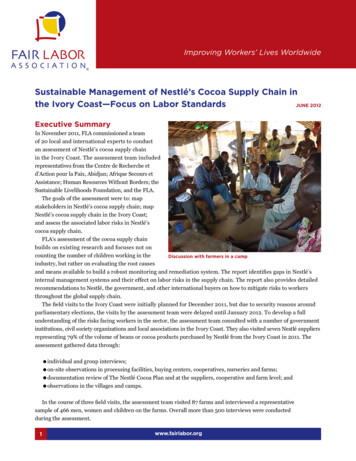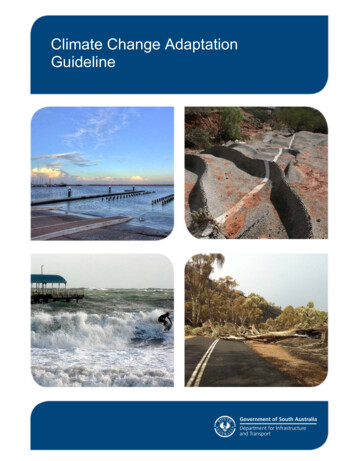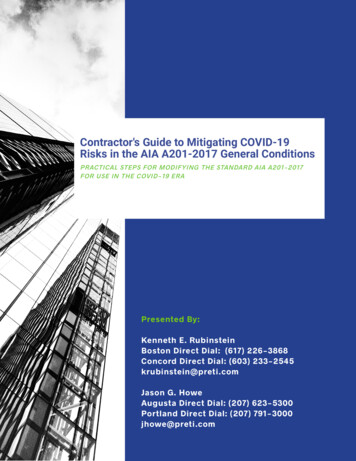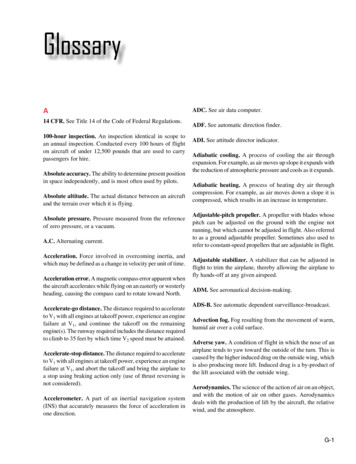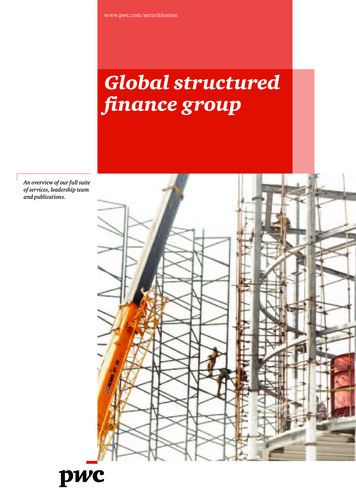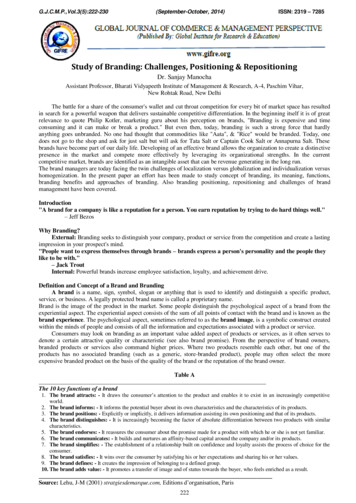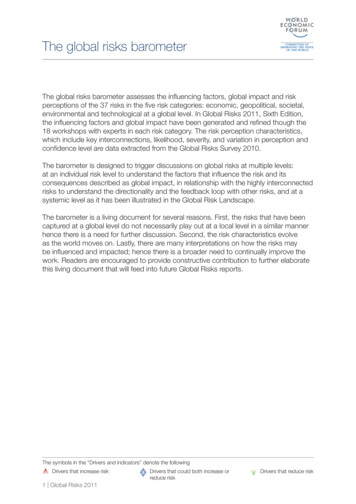
Transcription
The global risks barometerThe global risks barometer assesses the influencing factors, global impact and riskperceptions of the 37 risks in the five risk categories: economic, geopolitical, societal,environmental and technological at a global level. In Global Risks 2011, Sixth Edition,the influencing factors and global impact have been generated and refined though the18 workshops with experts in each risk category. The risk perception characteristics,which include key interconnections, likelihood, severity, and variation in perception andconfidence level are data extracted from the Global Risks Survey 2010.The barometer is designed to trigger discussions on global risks at multiple levels:at an individual risk level to understand the factors that influence the risk and itsconsequences described as global impact, in relationship with the highly interconnectedrisks to understand the directionality and the feedback loop with other risks, and at asystemic level as it has been illustrated in the Global Risk Landscape.The barometer is a living document for several reasons. First, the risks that have beencaptured at a global level do not necessarily play out at a local level in a similar mannerhence there is a need for further discussion. Second, the risk characteristics evolveas the world moves on. Lastly, there are many interpretations on how the risks maybe influenced and impacted; hence there is a broader need to continually improve thework. Readers are encouraged to provide constructive contribution to further elaboratethis living document that will feed into future Global Risks reports.The symbols in the “Drivers and indicators” denote the followingDrivers that increase risk1 Global Risks 2011Drivers that could both increase orreduce riskDrivers that reduce risk
The global risks barometerEconomic RisksFigure 1Figure 1lowAsset pricecollapseFigure 1medhighPerceived likelihoodto occur in the next ten yearsPerceived impactin Billion US A collapse of real and financial asset prices leads to the destruction of wealth, deleveraging, reduced householdspending and impaired aggregate demand.Drivers and indicatorsGlobal impactSharp increase and volatility in the prices of financial assetsincluding mortgages, asset-backed securities and debt instrumentsSharp increase and volatility in prices of real assets(commercial and private real estate)Excessive capital flows to emerging markets, inducing asset pricebubblesNew arbitrage opportunities, causing currency carry tradesfrom low-to high-interest rate countriesChanges in central bank policy frameworks which allocate moreweight to overall financial stability rather than just price stabilityPolicy shifts encouraging domestic consumption and creatingfurther productive investment opportunities in emerging economiesReversals of global economicgrowth as collapse in asset pricesundermines consumer confidenceand the allocative efficiency of thefinancial system (the current financialcrisis reduced world output byroughly 2% and contracted advancedeconomies by roughly 4%).Possible collapse of bankingsystems as investors lose trust infinancial markets and governanceinstitutions.Greater transparency and stronger financial regulation regardingsurveillance, capital and liquidity ratios, risk retention and counterpartyrisk management in over-the-counter derivative marketsThe symbols in the “Drivers and indicators” denote the followingDrivers that increase risk2 Global Risks 2011Drivers that could both increase orreduce riskDrivers that reduce risk
The global risks barometerEconomic RisksFigure 1ExtremeFigure 1commodityprice volatilitylowmedhighPerceived likelihoodto occur in the next ten yearsPerceived impactin Billion US Volatile mineral, metal and agricultural commodity prices create uncertainty for governments and business as wellas costs for producers and consumers.Drivers and indicatorsGlobal impactGovernment policies such as price ceilings on food prices, lead toreallocation of production and food shortagesFluctuating economic growth in emerging market economiesFluctuations as a function of the global business cycleCurrency devaluation should a number of countries attempt to shiftthe relative strength of their currencies to spur exportsClimate change and extreme weather events which increaseproduction uncertaintyRetrenchment from globalization, through e.g. protectionist barriersand “resource nationalism” from countries possessing rare metalsLower growth as volatility causesuncertainty for investments byindividuals and companies (such asfarmers and mining companies)Volatile and rising food prices lead tohunger and malnutrition among thepoor where food accounts for a largeproportion of household spending orearnings.The global business cycle may beexacerbated by commodity pricefluctuations.Advances in new information and communication technologiesthat smooth price fluctuations by improving information flow betweensellers, buyers and middlemenAdvances in agricultural technologies that create more resilientcropsAdvances in financial instruments that allow consumers andproducers of commodities to manage better risks associated withvolatile production levelsThe symbols in the “Drivers and indicators” denote the followingDrivers that increase risk3 Global Risks 2011Drivers that could both increase orreduce riskDrivers that reduce risk
The global risks barometerEconomic RisksFigure 1ExtremeFigure 1consumer pricevolatilitylowmedhighPerceived likelihoodto occur in the next ten yearsPerceived impactin Billion US Volatile prices for consumer goods and services distort demand, create uncertainty for governments and business,and increase costs for both producers and consumers.Drivers and indicatorsGlobal impactAggressive quantitative easingVolatile commodity pricesCollapse in asset prices leading to widespread failures in thefinancial sector with attendant recessionary impactHigh unemployment rates in combination with large and protractedoutput gapsEffective monetary policies that reduce the chance of severeswings towards inflation or deflationAn inflationary spiral couldimpoverish savers and creditorsand have adverse consequencesfor investment, growth and futureprosperity.A deflationary spiral could fosterprecautionary spending patternsthat may exacerbate recessionarytrends.The symbols in the “Drivers and indicators” denote the followingDrivers that increase risk4 Global Risks 2011Drivers that could both increase orreduce riskDrivers that reduce risk
The global risks barometerEconomic RisksFigure 1lowExtreme energyprice volatilityFigure 1medhighPerceived likelihoodto occur in the next ten yearsPerceived impactin Billion US Volatile energy prices create uncertainty for governments and business as well as costs for producers andconsumers.Drivers and indicatorsGlobal impactGeopolitical tensions and fear of terrorist activities especially in oilproducing and transit regionsHigh growth rates in emerging economiesUnderinvestment in the exploration and refinement of fossil fuelsRegulatory uncertainty over impending carbon pricing mechanismsand governanceIncrease in alternative energy production (e.g. solar and windpower) possibly leading to reduced dependency on fossil fuelsDampened economic growth asbusiness planning is disrupted andprice volatility feeds through into othergoods.Social unrest in countries whereheating costs account for a highproportion of household budgets.Substantially higher oil pricesgenerate current account surplusesin producing countries and deficitsin importing nations, exacerbatingglobal macroeconomic imbalancesand fuelling turbulence in financialmarkets.Possibility of an oil supply crunch.The symbols in the “Drivers and indicators” denote the followingDrivers that increase risk5 Global Risks 2011Drivers that could both increase orreduce riskDrivers that reduce risk
The global risks barometerEconomic RisksFigure 1lowFigure 1Fiscal crisesmedhighPerceived likelihoodto occur in the next ten yearsPerceived impactin Billion US Excessive debt burdens generate rising interest rates, inflation pressures and sovereign debt crises.Drivers and indicatorsGlobal impactRising debt levels and fiscal deficits in advanced economiesRising market interest ratesIncreasing dependency ratios and demographic challenges (forexample due to ageing in advanced economies)Clear exit strategies on behalf of governments holding high andrising levels of debtPersistently high rates of inflationSocial security and healthcare systems reform to a sustainablelevel while providing necessary level of social safety netHigh government debt-to-GDPratios stifle economic growth andexert upward pressure on real interestrates.In highly indebted economies,spreads on government bondsmay rise significantly, exacerbatingsovereign debt crises, particularly insome OECD countries.Sovereign debt crises in Eurozonecountries threaten Europeaneconomic integration, with negativeimpacts on other blocs consideringcurrency unions and the potentialto precipitate wider retreats fromglobalization.Fiscal austerity leads to cutbacksin innovation and educationprogrammes with long-termopportunity costs.Potential for social unrest andpolitical instability resulting from thebreakdown of social safety nets.The symbols in the “Drivers and indicators” denote the followingDrivers that increase risk6 Global Risks 2011Drivers that could both increase orreduce riskDrivers that reduce risk
The global risks barometerEconomic RisksGlobal Figure 1imbalances andcurrency volatilitylowmedhighPerceived likelihoodto occur in the next ten yearsPerceived impactin Billion US Global savings and investment imbalances foster unsustainable current account imbalances, unsustainable levels ofexternal debt and ultimately wide swings in foreign exchange rates.Drivers and indicatorsGlobal impactIncrease in the absolute size of current account imbalancesSubstantial changes in the conduct of monetary policy such asquantitative easingCompetitive devaluations of currenciesHigh number of potentially misaligned currency pegs maintainedContinued reliance on the US dollar despite its loss in value due tono other alternative international settlement currency, particularly inthe context of a disruption in the EuroExtent to which debtor countries are able to address fiscalchallenges and surplus countries are able to balance consumptionwith savingsMeaningful growth policies that change the incentives for theuse of income in both deficit and surplus countries so as to reduceimbalancesThe correction of globalimbalances typically comes at theprice of sharp income contractionsand adverse foreign exchangedevelopments in deficit countries.Currency volatility adverselyaffects trade and may lead to anincrease in protectionist measures,retrenchment from globalizationand additional global governancefailures.Running sustained and large currentaccount deficits requires capitalinflows on the part of deficit countries.This implies an increase in public debtwhen accompanied by fiscal deficits,leading potentially to fiscal crises.The symbols in the “Drivers and indicators” denote the followingDrivers that increase risk7 Global Risks 2011Drivers that could both increase orreduce riskDrivers that reduce risk
The global risks barometerEconomic RisksFigure 1lowInfrastructurefragilityFigure 1medhighPerceived likelihoodto occur in the next ten yearsPerceived impactin Billion US The failure to adequately invest in, upgrade and secure infrastructure networks severely hinders growth anddevelopment, and reduces the resilience of infrastructure networks to endogenous or exogenous shocks.Drivers and indicatorsGlobal impactConstraints on fiscal budgets and decisions to reduce infrastructurespendingLack of security standards and guidance provided by governmentsto address vulnerability of critical information infrastructure and powergrids to attempted attacksIncreasing capacity and inclination of terrorist networks to targetinfrastructure for political objectivesPopulation growth and urbanization increasingly putting stress onexisting infrastructureIncreases in access to credit by the private sector to finance largeinfrastructure projectsIncreased transaction costs anddisruption to business caused byinadequate or failing infrastructure.Unsustainable demand for naturalresources and associated damageto the environment caused byinefficient distribution of water, energyand sanitation services.Domino effects frominterdependencies of criticalinfrastructure, intensifying crisissituations.International cooperation on regionally facing critical infrastructureThe symbols in the “Drivers and indicators” denote the followingDrivers that increase risk8 Global Risks 2011Drivers that could both increase orreduce riskDrivers that reduce risk
The global risks barometerEconomic RisksFigure 1lowLiquidity/creditcrunchFigure 1medhighPerceived likelihoodto occur in the next ten yearsPerceived impactin Billion US Reductions in the availability of liquidity, loans and credit from banks and capital markets increase borrowingcosts for governments, businesses and consumers, deter investment and negatively impact financial markets andeconomic activity.Drivers and indicatorsGlobal impactLack of availability of credit leading to credit rationingNegative financial conditions both in deposit-taking banks and theshadow banking (non-bank) sector, including deteriorating capitalratios and asset impairmentsCollapse of asset prices, includingfinancial assets and real estate,leading to a sharp and protractedrecession.New regulations which successfully address moral hazard andconflicts of interest in the financial systemConsistently low interest rates, guarantees and other measures whichencourage inter-bank lendingThe symbols in the “Drivers and indicators” denote the followingDrivers that increase risk9 Global Risks 2011Drivers that could both increase orreduce riskDrivers that reduce risk
The global risks barometerEconomic RiskslowRegulatoryfailuresFigure 1medhighPerceived likelihoodto occur in the next ten yearsPerceived impactin Billion US Inadequate, fragmented or obsolete regulations, institutions or reforms negatively impact industry structures, capitalflows and market competition, constraining both investment and innovation, and the effectiveness of internationalcooperation.Drivers and indicatorsGlobal impactImpact of interest groups on regulatory process in the form of shortterm responses to structural challengesCommitment to multistakeholder and international dialogueon regulatory challenges with a focus on understanding opposingincentives and conflicting perspectivesHigher levels of effective coordination among national regulatorsDistortions to capital allocation and/or increased costs of doing business,leading to reduced profitability andhigher product prices.Increased risk of failure ofinternational structures such as theG20 with knock-on geo-economicand geopolitical effects.The symbols in the “Drivers and indicators” denote the followingDrivers that increase risk10 Global Risks 2011Drivers that could both increase orreduce riskDrivers that reduce risk
The global risks barometerEconomic RisksRetrenchmentFigure 1fromglobalizationlowmedhighPerceived likelihoodto occur in the next ten yearsPerceived impactin Billion US Economies adopt policies that create barriers to flows of goods, capital and labour, while failing to engage withmultilateral governance structures to address global challenges.Drivers and indicatorsGlobal impactImplementation of implicit and explicit trade barriers throughtariffs, subsidies, national content requirements, etc.Increasing populist politics fed by slow growth and high levels ofunemploymentIncreased hurdles to cross-border migrationDeclines in global trade and theefficiency of global capital marketslead to decreases in innovation andeconomic growth.Welfare losses and higher levels ofpoverty globally.Tangible progress in international trade negotiations such as theDoha RoundSuccessful negotiations in bilateral and regional trade agreementsThe symbols in the “Drivers and indicators” denote the followingDrivers that increase risk11 Global Risks 2011Drivers that could both increase orreduce riskDrivers that reduce risk
The global risks barometerEconomic RisksSlowingFigure 1Chineseeconomy ( 6%)lowmedhighPerceived likelihoodto occur in the next ten yearsPerceived impactin Billion US China’s growth slows to 6% or less.Drivers and indicatorsGlobal impactSocial unrestExcessive savings and investment into unproductive assetsDemographic pressures due to China’s ageing populationChinese government’s ability to maintain political stability in thewake of loss in growth momentumChinese government’s success in maintaining stable renminbi in thewake of loss in export momentumAdverse effects on global capital andcommodity markets could foster areversal in globalization, as China isa large importer of commodities fromother emerging market countries.Its reserves are invested abroad(predominantly in US governmentbonds) and it has a sizeable presencein other countries through directinvestments in land and commodityproducers and through developmentaid.Bursting of an investment-driven,large-scale infrastructure andconstruction projects bubble.Socio-economic unrest due to risingunemployment rates.The symbols in the “Drivers and indicators” denote the followingDrivers that increase risk12 Global Risks 2011Drivers that could both increase orreduce riskDrivers that reduce risk
The global risks barometerGeopolitical RiskslowFigure 1CorruptionmedhighPerceived likelihoodto occur in the next ten yearsPerceived impactin Billion US The abuse of power for personal gain by businesses and public officials undermines the rule of law, governance,investment flows and economic development.Drivers and indicatorsGlobal impactInstitutional weakness in fragile statesEconomic disparity and low wagesContinuing or increasing levels of organized crime and illicit tradeRegulatory and global governance failuresCitizen education and information, including literacy, whichincrease opportunities for legitimate activities and raise awareness onthe impacts of corruptionIncreased transparency of global financial flowsStronger links between international civil society and legal institutionsin advanced economiesNational laws containing extraterritorial provisions to holdcompanies liable for corruption, such as the US Foreign CorruptPractices Act and United Kingdom Anti-Bribery BillIncreased transaction costs forbusinesses, governments andindividuals.Creating barriers to growthby reducing willingness to takebusiness risks and deterring foreigninvestment.Reduced levels of citizen trust ingovernment.Erosion of institutions and civilservice functions.Increasing security concerns forindividuals threatened by coercion.Increasing private sector engagement and commitment to reducecorruptionThe symbols in the “Drivers and indicators” denote the followingDrivers that increase risk13 Global Risks 2011Drivers that could both increase orreduce riskDrivers that reduce risk
The global risks barometerGeopolitical RisksExample of barometer “Fragile states”Figure 1lowFigure 1Fragile statesmedhighPerceived likelihoodto occur in the next ten yearsPerceived impactin Billion US One or more systemically critical countries experience the significant erosion of trust and mutual obligationsbetween states and citizens, leading to state collapse, internal violence, regional or global instability and, potentially,military conflict.Drivers and indicatorsGlobal impactImbalances in internal centres of power (civilian, military, economic,religious, etc.) and competition between domestic actors foreconomic and political resourcesThe proliferation of newly independent states with low economicand political resilienceWeakening social, political and economic bonds as a result ofinternal or external conflictIncreasing incidence of corruption, organized crime and illicit tradeEffective investments in local institution-building, education andhealth careStrong global governance and cooperation regarding internationalintervention and support for fragile statesIncreasing economic disparity,both within and between countries.Civil war and reduced humansecurity.Migration and displacement ofvulnerable populations.Disruptions to international trade andexchanges because of illicit tradeand organized crime.Increasing likelihood of geopoliticalconflict and terrorism.The symbols in the “Drivers and indicators” denote the followingDrivers that increase risk14 Global Risks 2011Drivers that could both increase orreduce riskDrivers that reduce risk
The global risks barometerGeopolitical RisksFigure 1lowGeopoliticalconflictFigure 1medhighPerceived likelihoodto occur in the next ten yearsPerceived impactin Billion US Military actions or aggressive foreign or trade policies on the part of global or regional powers disrupt political orsocial stability, negatively impacting populations, investment and financial markets.Drivers and indicatorsGlobal impactRising political populism at the national levelIncreased tension over territorial disputes, particularly those linkedto access to natural resources or strategic assetsFragile states which have the potential to fuel regional conflictRising tensions in the Middle East and the Korean peninsulaGlobal governance successes which decrease the likelihood ofmisunderstandings and miscalculations among states, and increasethe potential for dispute resolutionLoss of human lives throughwarfare.Loss of property and economicresources, at both personal andnational levels through warfare.Reinforces global governance failuresby creating new levels of distrustamong nations.Breaks global trade patterns andmay lead to reduced growth at aglobal level due to protectionistreactions (though national economiesmay be stimulated throughinnovation).The symbols in the “Drivers and indicators” denote the followingDrivers that increase risk15 Global Risks 2011Drivers that could both increase orreduce riskDrivers that reduce risk
The global risks barometerGeopolitical RisksGlobalFigure 1governancefailureslowmedhighPerceived likelihoodto occur in the next ten yearsin Billion US Weak or inadequate global institutions, agreements or networks, combined with competing national and politicalinterests, impede attempts to cooperate on addressing global risks.Drivers and indicatorsGlobal impactDiscrepancies in political views, incentives and decision-makingsystems between advanced and emerging economiesReluctance of established powers to acknowledge and adjust to therising power of emerging economiesIncreasing interconnectedness and complexity of global risks,which defy traditional governance responsesDisintermediation of traditional forms of leadership andgovernance through technological and social shiftsSustained success in implementing global agreements on climatechange based on UN mechanismsDevelopment of a well-informed and well-mobilized global publicopinion sharing norms and values of global citizenshipIncreased impact and likelihood ofother global risks and less-effectiveglobal risk response.Increasing likelihood of geopoliticalconflict through reduced means ofpeaceful settlement.Reduced global growth andeconomic inefficiency due toincreasing protectionism.Reduced trust among states byheightening divisions rather thancommonalities.Regulatory arbitrage opportunities.The symbols in the “Drivers and indicators” denote the followingDrivers that increase risk16 Global Risks 2011Drivers that could both increase orreduce riskDrivers that reduce risk
The global risks barometerGeopolitical RiskslowFigure 1Illicit trademedhighPerceived likelihoodto occur in the next ten yearsPerceived impactIncreases in the illegal trafficking of goods and people cause social, political, economic and environmental harm byincreasing the burden on supply chains, exacerbating wealth inequalities and financing destabilizing activities.Drivers and indicatorsGlobal impactState fragility which fosters illicit trade by facilitating the productionand export of illicit goods and servicesRising economic disparity which creates incentives for engaging inillicit trade as a source of employment and wealth creationGlobal governance failures, particularly in law enforcement, supplychain security and customs regulationsIncreased consumer education and awareness of the aggregateimpact of illicit tradeIncreasing financial and goods transparency, and trackingReduces public and private sectorrevenues and, in time, innovation, bydistorting markets and reducing taxbases.Stimulates corruption, organizedcrime and state fragility.Threatens biodiversity throughunregulated activities.Criminalization/marginalization ofsegments of the population.Regulatory and global governance reforms which reduceopportunities for regulatory arbitrageLegalization and decriminalization that shifts the dynamics ofdemand and supply of illicit goodsThe symbols in the “Drivers and indicators” denote the followingDrivers that increase risk17 Global Risks 2011Drivers that could both increase orreduce riskDrivers that reduce risk
The global risks barometerGeopolitical RisksFigure 1lowOrganizedcrimeFigure 1medhighPerceived likelihoodto occur in the next ten yearsPerceived impactin Billion US The unlawful activities of highly organized, disciplined associations weaken state authority, negatively impactinvestment climates, undermine the rule of law and slow growth.Drivers and indicatorsGlobal impactWeak institutions, attributable to both state fragility and corruptionRising economic disparity which creates incentives for engaging inorganized crime as a source of employment and wealth creationGlobal governance failures, particularly in law enforcement andintelligence gatheringIllicit trade activity, which is a primary occupation of organizedcriminal activities as well as a main source of incomeReduces public and private sectorrevenues by creating grey and blackmarkets, creating unfair competition,and reducing tax bases.Negative impacts reduce socialstability and security by creatingunsafe environments, which in turndeter tourism and investmentLegalization and decriminalization of illicit goods that alter the flow ofgoods and financing to organized crimeIncreasing financial and goods transparency and trackingGlobal cooperation on intelligence-sharing and law enforcementacross jurisdictions to identify and prosecute organized criminalsThe symbols in the “Drivers and indicators” denote the followingDrivers that increase risk18 Global Risks 2011Drivers that could both increase orreduce riskDrivers that reduce risk
The global risks barometerGeopolitical RiskslowFigure 1Space securitymedhighPerceived likelihoodto occur in the next ten yearsPerceived impactin Billion US The insufficient regulation of commercial and military activity in space jeopardizes potential economic, commercialand technological benefits derived from space exploration and leads to geopolitical tension and confrontation.Drivers and indicatorsGlobal impactIncreasing levels of activity in space make tensions or conflict inspace more likelyRising risks of traditional geopolitical conflict increases the likelihoodof conflict spilling over into spaceLack of global governance, in particular related to spacetechnologies and territorial rightsIncreasing levels of space debris that make space activitiesincreasingly unsafePossible direct impact on traditionalgeopolitical conflict on Earth due tothe intricate nature of state interest onEarth and in space.Reduced opportunities presentedby space as a new avenue foreconomic and human developmentby creating extreme uncertainties forinvestors, public and private.Human injury and loss of life fromattacks from or accidents in space.The symbols in the “Drivers and indicators” denote the followingDrivers that increase risk19 Global Risks 2011Drivers that could both increase orreduce riskDrivers that reduce risk
The global risks barometerGeopolitical RiskslowFigure 1TerrorismmedhighPerceived likelihoodto occur in the next ten yearsPerceived impactin Billion US Non-state actors are successful in impacting large-scale human or material damage.Drivers and indicatorsGlobal impactPolitical and religious radicalizationHuman injury and loss of life.Social fragmentation in both advanced and emerging economiesFear and psychological trauma bothin anticipation of terrorist acts and inthe aftermath of attacks.Rising economic disparity, which contributes to marginalizationIncreased mobility of people and informationExistence of fragile states which serve as safe havens and traininggrounds for terrorist organizationsDecreasing costs and barriers of access to low-end weapons ofmass destructionGeopolitical tension, instability and conflictImproved intelligence and tracking of terrorist-related activitiesthrough the InternetNew and credible peace efforts in Israel/Middle EastThe West’s pressure on terrorists’ sanctuaries in Afghanistan andthe Horn of AfricaReduced trust among people withinand between societies by creatingstigmas.Economic opportunity coststhrough preventive measures, fearof attacks and the direct impact ofincidences, particularly related totravel and tourism.Diplomatic and militaryescalations, which can both resultfrom and drive terrorist incidents.The symbols in the “Drivers and indicators” denote the followingDrivers that increase risk20 Global Risks 2011Drivers that could both increase orreduce riskDrivers that reduce risk
The global risks barometerGeopolitical RisksFigure 1WeaponsFigure 1of massdestructionlowmedhighPerceived likelihoodto occur in the next ten yearsPerceived impactin Billion US The proliferation of nuclear, chemical, biological and radiological technologies and materials leads to crises.Drivers and indicatorsGlobal impactIran’s nuclear ambitions
The symbols in the “Drivers and indicators” denote the following. The global risks barometer. The global risks barometer assesses the influencing factors, global impact and risk . perceptions of the 37 risks in the five risk categories: economic, geopolitical, soc

